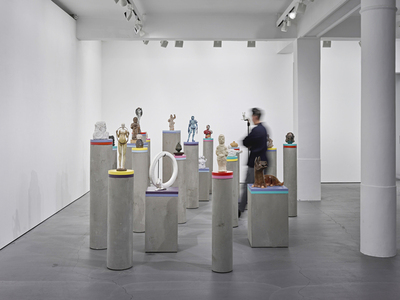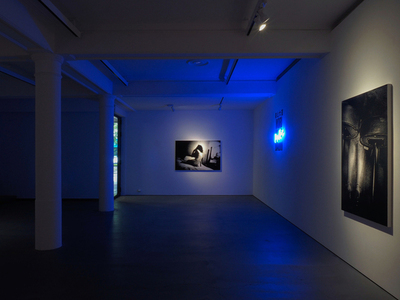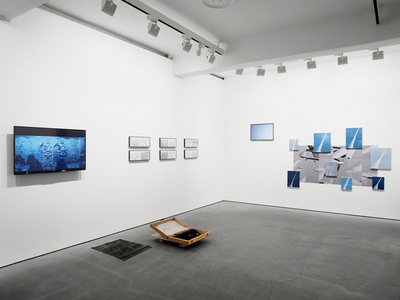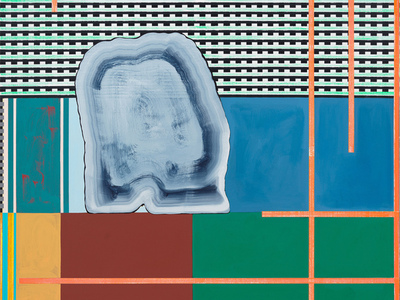Zhao Gang 21st: Supports / ColorLumps as Anthropography of History
May 1 – August 23, 2020
Opening reception: May 1, 2020 | 5 PM
Kuandu Museum of Fine Arts
Curator: Huang ChienHung
Organizer: Kuandu Museum of Fine Arts
Co-organizer: Each Modern
Special thanks to Long March Space, Tilton Gallery, TSO Gallery
Comprised of recent works the exhibition presents Zhao’s history painting practice as an examination subjectivity and of the premise of History itself. Across two floors of the Kuandu Museum, with works ranging from small watercolor on paper to immersive large-scale oil on canvas, this collection of works proposes viewing the artist and his painting in a broad view which challenges our assumptions of history and the shaky ground which it undoubtedly has always stood on. This challenge extends beyond merely serving a missive debunking the fallacies wrought throughout Chinese cultural history, but also encompasses the ontology of painting itself. What is worth gleaning from this past? What is worth saving? And What does painting have left to offer? Zhao Gang’s paintings offer some sort of answer. Skeptical, coarse, and bawdy answers, though answers nonetheless.
Born 1961, his family’s Manchu pedigree attracted considerable castigation during the Cultural Revolution. As the youngest member of the Stars Group, Zhao Gang contributed to China’s earliest modern art exhibitions from the late seventies to the mid-eighties. His activity in a cohort of non-institutionalized artists formed a community of the avant-garde, traveling on bicycles between apartment exhibitions across night-time Beijing. He left China, just before the Anti-Spiritual Pollution crackdowns, to study in the Netherlands in 1983 and later attended Vassar College in the United States. In New York he played a role in pulling not only a community of Chinese avant-garde artists together, but also created spaces for dialogues with African American artists, and even purchased and ran the art magazine Art Asia Pacific for a spell. He lived and worked in New York for over twenty Years before returning to Beijing in 2007, to find a new China, and a new topography of Chinese Contemporary Art.
Zhao Gang the returnee found a Beijing he did not fully recognize. To engage with this new landscape, the artist continued what began in New York in the 90s, a practice towards the more personal, one that revolved around his specific identity, but that stretched back towards history to question the present, drawing from erotica, revolution, poetry, traditional ink painting, Chinese culture’s past. In this way, through the personal, Zhao depicts a new Chinese imaginary, explored through painting, about painting, and about himself.
One such recurring topic is the often-unrecognized heterogeneity of China, or the non-Chinese within China. In the exhibition’s largest work China Party 2020, 2019, a panoply of figures makes up this party. A “verdant-robed girl,” a bearded Taoist, and generals and a Qin emperor gathered around a table project a colorful rainbow of a multifaceted Chinese culture. Upon more rigorous inspection, the figures are in fact all wearing the attire of non-Han Chinese, or non-Chinese altogether. Reframed in this context, and rendered with harsh and direct brush strokes, stripping the forms of their historical context and revealing an interior identity of shape and color, Zhao gives these non-Chinese, Chinese, a contemporary subjectivity through the inherited and the traditional; one that regards China from within and without.
Comprising another facet of this subjectivity is a body of work from 2018 titled Diluted Retrospective, featuring 39 watercolors. The series frames Russia’s October Revolution in a context that includes Chinese history and Zhao himself while addressing identity through links between China, communist revolutions, and also Contemporary Art history. For Zhao, coming of age in China meant there was never one’s own Contemporary Art history. Instead what the artist offers is a mix of revolutionary warlords, intellectuals, and the legacy of Imperial China. Once again, through the medium of painting, Zhao Gang is able to shine a light on a precarious aspect of his world, through a retrospective turn.
Intellectual, 2015 - 2017 is a work which is tied to one a body of work fixated on a certain group of Chinese intellectuals who took off to Europe, the US, and Japan, post May Fourth Movement to receive higher education. Returning to China, with hopes and dreams of building a better homeland, many of these would-be statesmen meet unenviable fates. The theme of the simultaneous outsider and insider is no doubt ever present in Zhao’s works as he’s framed it. He is the contemporary analog of these men though in spite of this, has a different destiny.
Importantly this exhibition also draws our attention to deeper displacement with time, shifting from history and sociocultural anthropology, to biological anthropology. Monkey King, 2016 touches upon the very origin of homo-sapiens, that is mankind’s prehistoric antecedents. Betraying his tendency towards parody, Zhao shows us a sincere creature with potential and intelligence. A figure about to relinquish its throne in the kingdom of animals, and begin the heavy lifting of human civilization. Bright eyes looking out from the canvas, perhaps forward towards the march of human history to come, suggest a range of concern that goes even deeper for Zhao. If traditional Chinese philosophers looked towards the ancients for guidance, Zhao’s aim may be even further back.
Whether these portraits represent aspects of the Zhao’s identity or narrative are no longer in question. Almost all of the works are imbued with some piece of his own historical fate. What Intellectual, 2015 - 2017 and Monkey King, 2016 offer us is representation of this spectrum. The former is the amalgam of cultures, the latter predates culture. One figure suffers a cruel fate at the hands of his own people, despite his learning, the other is removed from this strife because it sits outside the troubles of mankind. Zhao makes clear his position on his circumstance, as Manchu, artist, emigrant, returnee, insider and outsider. History has shown, good intentions and intellect do not exclude you from man’s barbarism.
Another cycle repositions Zhao through court culture and the landscapes from literati gardens. In Coronavirus 3, 2020 and Coronavirus 4, 2020, objects appear from edges of the canvas, cutting off, and de-contextualizing these traditional objects of value. A statue of a buddha becomes an emptied vessel of Chinese culture, both removed from the world that created it, and the people that comprise this culture. Zhao picks and chooses these aspects, not discarding, though not accepting at face value either. This technique draws parallels with his Suzhou Museum solo exhibition “Paramour’s Garden” from 2015 and its watercolors of floating figures and architecture, though these oil on canvas works are grounded, and enclosed in interiors, there still a sense of the unhinged.
Landscapes and vistas of China can also be seen through eyes of outsiders, not unlike Zhao. Map of China, 2015 takes its inspiration from the cover of German traveler and scientist Ferdinand von Richthofen’s 1885 book. A stone stele stands before rolling hills and the Great Wall. Here the foreigner’s imaginary is invoked; a western depiction of an essentialist view of China is re-appropriated by Zhao, and reworked, but with his assimilated western subjectivity. A mirror is held up to a mirror.
The contemporary is never too far away, and as such neither is history or the historical events that will dot future annals. In fact, the Coronavirus series is comprised of 4 works done in Beijing during the height of the COVID-19 viral epidemic across China. In this context, Zhao’s practice persisted. In the first of the series, Coronavirus 1, 2020, a small dark plant in front of a sill, with a window pane divided into sections, reframes the scene into two pieces. Looking out through these panes, a near-void of white freezes the world in place. Cascading sheets of snow blanket roof tops towards a horizon of grey and dead trees. The red flowers of the houseplant pull us back indoors and out of the cold. Taken with its historical context, Zhao puts the very real aspect of separation, isolation, endurance and tenacity of the spirit born in the face of a contemporary crisis into this historical medium and subject.
He is an outsider of the fiction that we call a unified Chinese culture. Zhao sees this within these inherited images, trickling down to our present. Filtered through the artist, and through the baggage of painting and painter, these things can take on new meanings, enforce new myths, and posit new histories. No other artist, Chinese, American, or otherwise, has had the singular frame of mind to share such a vision.
Opening reception: May 1, 2020 | 5 PM
Kuandu Museum of Fine Arts
Curator: Huang ChienHung
Organizer: Kuandu Museum of Fine Arts
Co-organizer: Each Modern
Special thanks to Long March Space, Tilton Gallery, TSO Gallery
Comprised of recent works the exhibition presents Zhao’s history painting practice as an examination subjectivity and of the premise of History itself. Across two floors of the Kuandu Museum, with works ranging from small watercolor on paper to immersive large-scale oil on canvas, this collection of works proposes viewing the artist and his painting in a broad view which challenges our assumptions of history and the shaky ground which it undoubtedly has always stood on. This challenge extends beyond merely serving a missive debunking the fallacies wrought throughout Chinese cultural history, but also encompasses the ontology of painting itself. What is worth gleaning from this past? What is worth saving? And What does painting have left to offer? Zhao Gang’s paintings offer some sort of answer. Skeptical, coarse, and bawdy answers, though answers nonetheless.
Born 1961, his family’s Manchu pedigree attracted considerable castigation during the Cultural Revolution. As the youngest member of the Stars Group, Zhao Gang contributed to China’s earliest modern art exhibitions from the late seventies to the mid-eighties. His activity in a cohort of non-institutionalized artists formed a community of the avant-garde, traveling on bicycles between apartment exhibitions across night-time Beijing. He left China, just before the Anti-Spiritual Pollution crackdowns, to study in the Netherlands in 1983 and later attended Vassar College in the United States. In New York he played a role in pulling not only a community of Chinese avant-garde artists together, but also created spaces for dialogues with African American artists, and even purchased and ran the art magazine Art Asia Pacific for a spell. He lived and worked in New York for over twenty Years before returning to Beijing in 2007, to find a new China, and a new topography of Chinese Contemporary Art.
Zhao Gang the returnee found a Beijing he did not fully recognize. To engage with this new landscape, the artist continued what began in New York in the 90s, a practice towards the more personal, one that revolved around his specific identity, but that stretched back towards history to question the present, drawing from erotica, revolution, poetry, traditional ink painting, Chinese culture’s past. In this way, through the personal, Zhao depicts a new Chinese imaginary, explored through painting, about painting, and about himself.
One such recurring topic is the often-unrecognized heterogeneity of China, or the non-Chinese within China. In the exhibition’s largest work China Party 2020, 2019, a panoply of figures makes up this party. A “verdant-robed girl,” a bearded Taoist, and generals and a Qin emperor gathered around a table project a colorful rainbow of a multifaceted Chinese culture. Upon more rigorous inspection, the figures are in fact all wearing the attire of non-Han Chinese, or non-Chinese altogether. Reframed in this context, and rendered with harsh and direct brush strokes, stripping the forms of their historical context and revealing an interior identity of shape and color, Zhao gives these non-Chinese, Chinese, a contemporary subjectivity through the inherited and the traditional; one that regards China from within and without.
Comprising another facet of this subjectivity is a body of work from 2018 titled Diluted Retrospective, featuring 39 watercolors. The series frames Russia’s October Revolution in a context that includes Chinese history and Zhao himself while addressing identity through links between China, communist revolutions, and also Contemporary Art history. For Zhao, coming of age in China meant there was never one’s own Contemporary Art history. Instead what the artist offers is a mix of revolutionary warlords, intellectuals, and the legacy of Imperial China. Once again, through the medium of painting, Zhao Gang is able to shine a light on a precarious aspect of his world, through a retrospective turn.
Intellectual, 2015 - 2017 is a work which is tied to one a body of work fixated on a certain group of Chinese intellectuals who took off to Europe, the US, and Japan, post May Fourth Movement to receive higher education. Returning to China, with hopes and dreams of building a better homeland, many of these would-be statesmen meet unenviable fates. The theme of the simultaneous outsider and insider is no doubt ever present in Zhao’s works as he’s framed it. He is the contemporary analog of these men though in spite of this, has a different destiny.
Importantly this exhibition also draws our attention to deeper displacement with time, shifting from history and sociocultural anthropology, to biological anthropology. Monkey King, 2016 touches upon the very origin of homo-sapiens, that is mankind’s prehistoric antecedents. Betraying his tendency towards parody, Zhao shows us a sincere creature with potential and intelligence. A figure about to relinquish its throne in the kingdom of animals, and begin the heavy lifting of human civilization. Bright eyes looking out from the canvas, perhaps forward towards the march of human history to come, suggest a range of concern that goes even deeper for Zhao. If traditional Chinese philosophers looked towards the ancients for guidance, Zhao’s aim may be even further back.
Whether these portraits represent aspects of the Zhao’s identity or narrative are no longer in question. Almost all of the works are imbued with some piece of his own historical fate. What Intellectual, 2015 - 2017 and Monkey King, 2016 offer us is representation of this spectrum. The former is the amalgam of cultures, the latter predates culture. One figure suffers a cruel fate at the hands of his own people, despite his learning, the other is removed from this strife because it sits outside the troubles of mankind. Zhao makes clear his position on his circumstance, as Manchu, artist, emigrant, returnee, insider and outsider. History has shown, good intentions and intellect do not exclude you from man’s barbarism.
Another cycle repositions Zhao through court culture and the landscapes from literati gardens. In Coronavirus 3, 2020 and Coronavirus 4, 2020, objects appear from edges of the canvas, cutting off, and de-contextualizing these traditional objects of value. A statue of a buddha becomes an emptied vessel of Chinese culture, both removed from the world that created it, and the people that comprise this culture. Zhao picks and chooses these aspects, not discarding, though not accepting at face value either. This technique draws parallels with his Suzhou Museum solo exhibition “Paramour’s Garden” from 2015 and its watercolors of floating figures and architecture, though these oil on canvas works are grounded, and enclosed in interiors, there still a sense of the unhinged.
Landscapes and vistas of China can also be seen through eyes of outsiders, not unlike Zhao. Map of China, 2015 takes its inspiration from the cover of German traveler and scientist Ferdinand von Richthofen’s 1885 book. A stone stele stands before rolling hills and the Great Wall. Here the foreigner’s imaginary is invoked; a western depiction of an essentialist view of China is re-appropriated by Zhao, and reworked, but with his assimilated western subjectivity. A mirror is held up to a mirror.
The contemporary is never too far away, and as such neither is history or the historical events that will dot future annals. In fact, the Coronavirus series is comprised of 4 works done in Beijing during the height of the COVID-19 viral epidemic across China. In this context, Zhao’s practice persisted. In the first of the series, Coronavirus 1, 2020, a small dark plant in front of a sill, with a window pane divided into sections, reframes the scene into two pieces. Looking out through these panes, a near-void of white freezes the world in place. Cascading sheets of snow blanket roof tops towards a horizon of grey and dead trees. The red flowers of the houseplant pull us back indoors and out of the cold. Taken with its historical context, Zhao puts the very real aspect of separation, isolation, endurance and tenacity of the spirit born in the face of a contemporary crisis into this historical medium and subject.
He is an outsider of the fiction that we call a unified Chinese culture. Zhao sees this within these inherited images, trickling down to our present. Filtered through the artist, and through the baggage of painting and painter, these things can take on new meanings, enforce new myths, and posit new histories. No other artist, Chinese, American, or otherwise, has had the singular frame of mind to share such a vision.
2020-08-05
Information
| URL | https://eachmodern.com/exhibition/zhaogang21/ |
|---|---|
| 住所 | Kuandu Museum of Fine Arts |
その他
Antone Könst: Casual Magic
March 27 – April 25, 2020
Opening reception: March 27, 2020 | 6 - 8 PM
Each Modern is pleased to present “Antone Könst: Casual Magic” the artist’s first exhibition with the gallery, and in Asi...
Xu Qu: Desert
May 6 – June 6, 2020
Opening reception: May 6, 2020 | 5 – 7 pm
“In my mind the art market is like modern society: there is always an invisible hand controlling it.”
- Xu Qu, Fondation Louis ...
New Relic I: Crossing Over
July 31 – August 29, 2020
Opening Reception: July 31 (Fri.), 2020 | 6 p.m. – 8 p.m.
Ai WeiWei, Chen ShiauPeng, Juan Sea, Tseng ChienYing, Wang GuangYi, Wang TingYu, Wu ChuanLun, Xu Jiong
Antique...
Moriyama Daido: Pop Noir
September 11 – October 10, 2020
Opening Reception: September 11, 2020 | 6 - 8 PM
Each Modern is pleased to present “Moriyama Daido: Pop Noir” an exhibition of silkscreen on canvas works by semi...
Love Songs
October 22 – November 28, 2020
Opening reception: October 24 | 6 – 8 PM
Chin Sung
Liao Chi-chun
Shiy De-jinn
Lan ChungHsuan
Lee LiChung
Kao JunHonn
Wu Chi-Yu
Each...
Art Taipei 2020: PAINTINGS
Each Modern at Art Taipei 2020, booth B06
October 23 - 26, 2020
EGAN FRANTZ
HELL GETTE
HUANG HAIHSIN
ANTONE KÖNST
STEFAN MÜLLER
ARAKI NOBUYOSHI
Each Modern is pleased to present PAINTIN...






